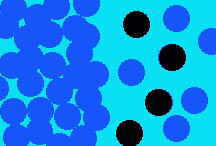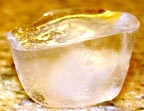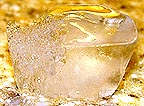

The Fascinating World of Salt and Ice ..An easy-to-understand explanation with pictures of why putting salt on ice melts it and makes ice/water mixtures colder.
(Click here to browse 70 topics on my main site ranging from magnetic rocket engines and more kaleidoscope pages to the strange world of lucid dreaming.)
Combining
ice and salt produces a remarkable yet easily understood reaction
that is important both to making ice cream at home and anywhere salt
is used on roads to melt ice. To understand this phenomena we first
need to take a close look at a plain ice-and-water mixture.

In the picture above the densely packed blue spheres on the left represent water molecules solidified into ice, the looser spheres on the right are water molecules. Ice consists of water molecules locked in a crystalline structure. Liquid water consists of free water molecules randomly moving around in all directions. (Note: in reality ice is less dense than water, which is why it floats. As water freezes the growing crystaline structure forces water molicules further apart than they are in liquid water. I've drawn the ice as close-packed molecules to simplify the image.)
Assuming there are no outside sources of heat or cold, the ice and water will be in equilibrium. However, this doesn't mean that everything is static. Every once in a while a free-swimming water molecule will collide with an ice molecule and in so doing give it sufficient energy to break away from the ice block. In other words that molecule just melted. Because the ice molecules are stuck together it takes energy to break a molecule free. In this case the energy came from the free-swimming water molecule that collided with the ice. It had a certain amount of energy stored in the form of kinetic energy, the energy it possessed because it was moving. (Just like a moving car has energy.) After the collision, the original free-swimming molecule will be moving slower and therefore have less energy. The difference between the amount of energy it had before and after the collision is same as the amount of energy it took to break the frozen ice molecule free. Imagine shooting a bullet through a pyramid of soda cans. As it knocks one of the cans off the stack it slows down a little. The can absorbed some of the bullet's energy to get dislodged from the rest of the cans.
In water, the temperature of the water is a measure of how fast the average water molecule is moving. The hotter the water, the faster the molecules move. When the water molecule above collided with the ice and as a result slowed down, it can now be thought of as being cooler. If this happens to enough water molecules the water as a whole will measure cooler.
Just as free-swimming water molecules can break loose ice molecules, so they themselves can collide with the ice in a way that causes them to stick to it, or freeze. In so doing they release energy to the water/ice mixture from their loss of kinetic energy and the energy given up as they create a molecular bond with the ice. This energy goes into the remaining water, making the molecules travel faster and in effect: heating it up.
In a stable mixture of water and ice the rate of ice molecules being broken free, and taking energy from the mixture, and water molecules freezing to the ice, and giving up energy to the mixture, is the same so that over time both the amount of water and ice and the temperature (a measure of the kinetic energy in the system) is constant.
But, let's say you want to melt the ice on your driveway. You sprinkle a little salt on it and like magic the ice starts to melt. Why?
Consider the following image:

Here we have the same water/ice mixture we had in the first picture, except this time salt (black spheres) has dissolved into the water and displaced some of the water molecules. Although the water now contains some salt molecules, the same number of collisions occur on the ice as before, maintaining the same rate of ice molecules being freed to join the free-swimming water molecules. BUT, because the salt molecules have replaced some of the water molecules in the water not as many water molecules collide with the ice and therefore there are fewer of them that can freeze to it. (The crystalline structure of the ice prohibit salt molecules striking the ice from becoming incorporated into it. The nature of the molecular bonds repels the salt.) Net result: there are more ice molecules melting than there are water molecules freezing. Because the salt isn't used up in this process the melting continues as long as the water flowing from the ice doesn't wash the salt away. This is why only a little salt is needed to melt a lot of ice.
A
Simple Experiment
That Shows This Happening:
Take an ice cube and sprinkle a pinch of salt on one-half of it and leave it in the refrigerator for ten minutes. In the image below a little salt was sprinkled on the left half of the cube:

A little while later the side with salt on it has melted much more than the unsalted side.

A close look shows that each salt grain creates its own tunnel down into the ice.
One curiosity about this process is that contrary to our everyday experience, the melting ice is actually colder than it was before the salt was added. There reason this is so is the same reason salt is added to home ice cream makers: to make the water/ice mixture cold enough to freeze the ice cream, which freezes below the temperature of normal ice.
To understand why the water/ ice mixture gets colder when salt is added we need to remember that as ice molecules melt they absorb energy from the mixture by causing the water molecules to slow down. Equally, when water freezes to the ice it gives up its energy and in so doing causes the surrounding molecules to speed up a little, or in other words get hotter. In a pure water/ice mixture the rate of both processes is equal so the mixture doesn't heat up or get colder. When salt is added the rate of melting stays the same and therefore so does the rate of energy being absorbed from the mixture. But, the rate of water molecules freezing to the ice is reduced and therefore so is the amount of energy being released by this process. Net result: more melting than freezing means that more energy is being absorbed by the mixture than is being released to it. Net result: the mixture gets colder.
Think of it like this: we all know it takes energy to melt ice. Normally we do this by adding heat. But, in the water/ice/salt situation the only source of heat (or energy) to melt the ice is the kinetic energy stored in the water and ice mixture itself. If some of that energy is used up breaking the molecular bonds between ice molecules then the total genetic energy of the system, as measured by its temperature, must decrease.
IMPORTANT NOTE:
The subject of ice is much more complex that the simplified explanation on this page suggests. For more detailed treatments try: http://www.chem1.com/acad/sci/aboutwater.html and http://www.lsbu.ac.uk/water/index2.html.
(Click
here to browse 70 topics on my main
site ranging from magnetic rocket engines and more kaleidoscopes
pages to the strange world of lucid dreaming.)